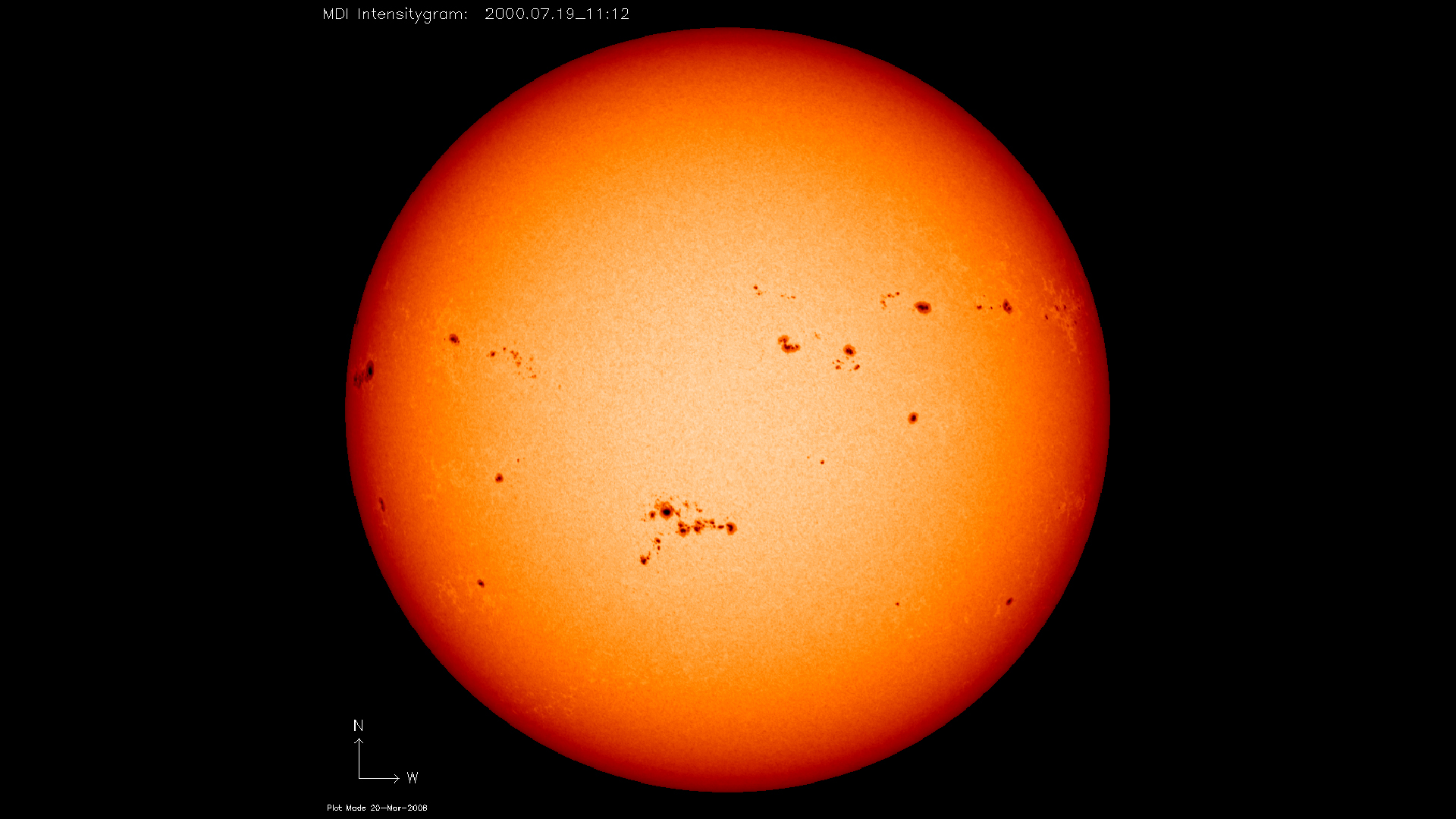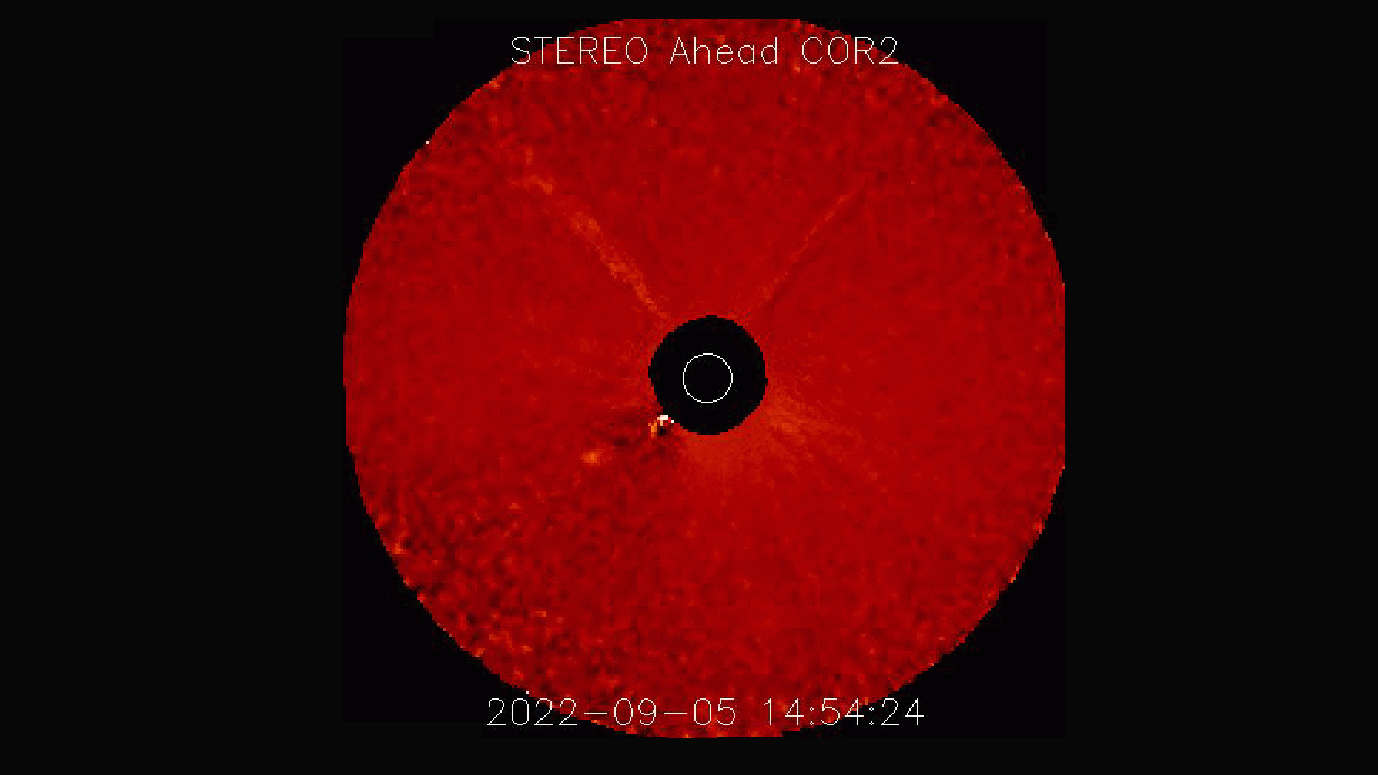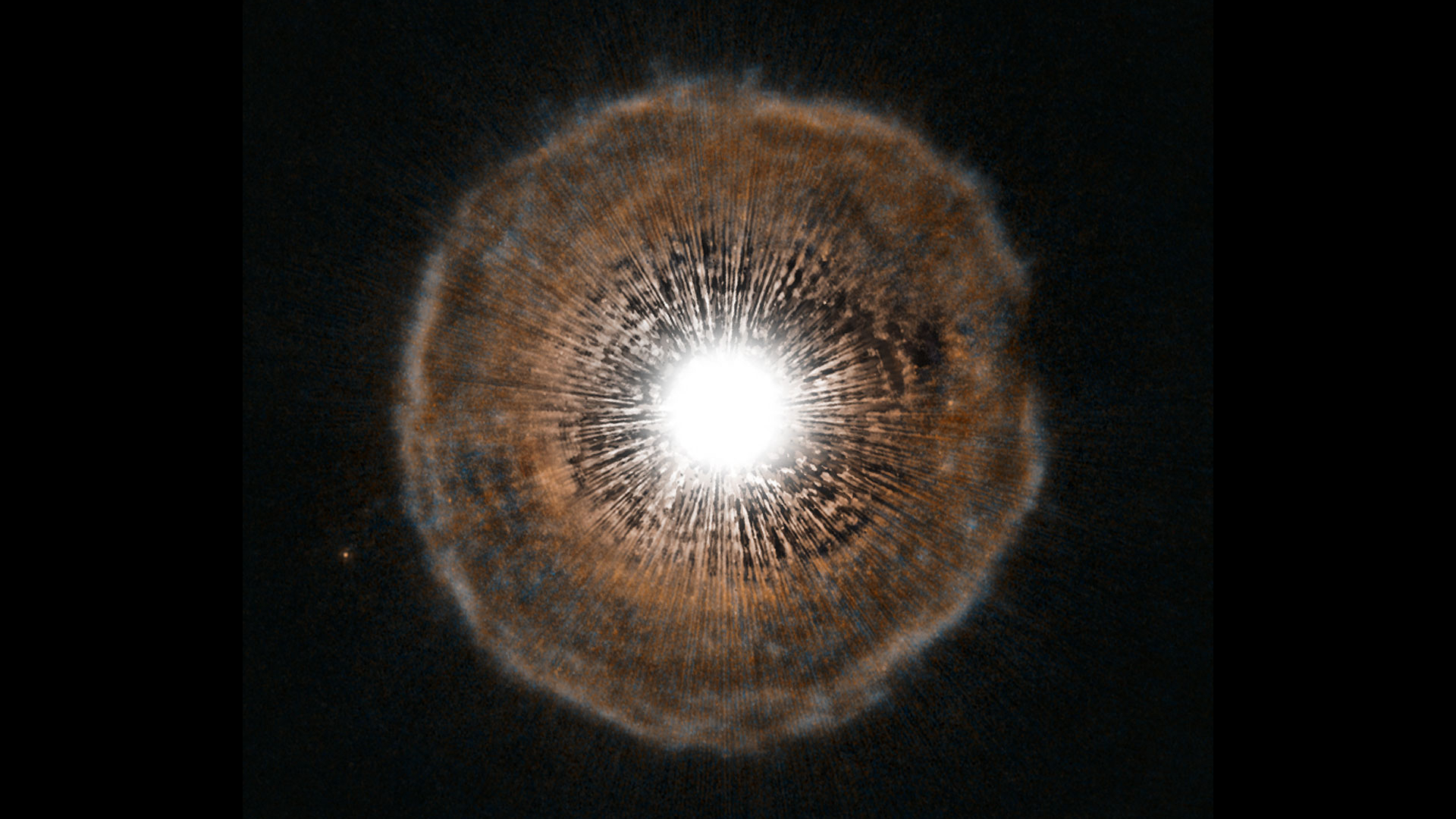What is the mass of the sun?
And how will it change over time?

The sun is the most massive object in the solar system, with far more mass than all of the planets that orbit it, including the Earth, combined.
The mass of the sun is almost 4.4 × 1030 lbs (2 x 1030 kilograms), that is 4.4 followed by 30 zeros, equivalent to about 333,000 Earths. This value is defined as a solar mass and becomes important when considering the masses of other stars which are, perhaps unsurprisingly, measured in terms of solar masses.
This mass is vital to the energy produced by the sun and producing light that shines from it. The sun's mass is not just integral to the solar system today, it will shape the future of our planetary system and the fate of our star itself.
Related: How hot is the sun?
Mass is a description of the resistance a body of matter offers to a change in its speed or position upon the application of a force, according to Britannica it considers how much "stuff" is in an object. The standard unit of mass is a kilogram (one kilogram is equal to approximately 2.2. lbs), which might be familiar to you as a unit of weight.
Mass and weight are distinct because weight is a measure of the size of the pull of gravity on the object. So the mass of a rubber ball on Earth would remain the same on the moon, but its weight would change because of the reduction in gravitational pull.
To get a picture of just how massive this makes our star we can compare that to the planets and the solar system as a whole.
Sun's mass and the solar system
Of all the mass contained within the solar system, NASA says that 99.8% of it is locked up in the sun. Around 4.6 billion years ago a disk of gas and dust collapsed to birth our star and what material didn't go into the sun was leftover as a planetary nebula from which the planets emerged.
Of these planets, the most massive is Jupiter, which is also the second most massive object in the solar system after the sun. Jupiter has a mass of 4.2 × 1027 lbs (1.9 × 1027 kgs), according to NASA. This means the sun is almost exactly three orders of magnitude, or 1,000 times, more massive than the gas giant.
Jupiter in turn is around 1,000 times greater in mass than our planet, the Earth which has a mass of around 1.3 × 1025 lbs (5.9 x 1024 kgs).
Clearly, the sun dominates the planets in terms of mass, but what about other stars? Can our star retain its dominance beyond the solar system?
Related: How to observe the sun safely (and what to look for)
Sun's mass FAQs answered by an expert
We asked Manchester University Professor of Astrophysics Albert Zijlistra, some questions about the sun and its mass.

Albert Zijlistra is a professor of astrophysics at Manchester University, U.K.
In terms of mass, how does the sun compare to other stars?
The lowest-mass star has about 10% of the mass of the sun, that's the lowest you get. The most massive stars have a mass 100s of times that of the sun. So the sun is sitting somewhere within a very large range. It's not at the bottom, and it's not at the top, but the sun is closer to the bottom.
But low-mass stars, stars that are less massive than the sun, are much more common than high-mass stars. So if you've got 20 stars picked randomly 19 will be less massive than the sun, and only one will be more massive. So from that point of view, the sun is actually on the more massive side of most of the stars.
How does the sun compare with the planets in terms of mass?
Ha ha, it's quite a bit bigger. If you look at the solar system, when we've got eight planets, the sun, and a lot of small debris. All the planets add up to only about 0.1% of the mass of the solar system, so in the whole solar system, the sun is 99.9% of the total mass. Of the mass that is left, only about 0.1% is in the Earth.
How is the sun losing mass?
The sun is losing mass in several ways. The main way the sun is losing mass is through nuclear fusion in its core. Fusion is changing hydrogen to helium, the hydrogen used weighs slightly more than the helium produced. The difference is changed to energy with a little help from Einstein's E = mc² and this energy is what we see as light.
You've also got solar wind, which at about [310 miles] 500 kilometers a second, is pretty fast, and it's steady it carries mass away all the time. The solar wind is just driven by the energy and the temperature of the sun and the wind is then flowing out from the sun. Most people already talk about solar wind but don't think about these big events called coronal mass ejections. So You suddenly get a big flare and the sun loses a lot of mass in one go.
So the sun loses a little bit of mass in the solar wind, and about three times as much in nuclear fusion. But even if you add all that together, that is still nothing compared to the mass of the sun. The sun is something like a million times more massive than the Earth and loses an amount of mass equal to the mass of the Earth about every 100 million years. So compared to the sun's lifetime of 10 billion years, compared to the mass of the sun that is nothing. So by the time the sun becomes a red giant and has finished the normal nuclear burning, it will still have pretty much the same mass as it has now.
Is this mass loss activity a phenomenon that is common in stars?
Yes! In fact, the sun is not a particularly active star, it is actually a very quiet star compared to many that we know of. That's probably to do with its age, at about 5 billion years old the sun is getting on a bit.
How does the sun measure up to other stars?
The most massive star ever discovered, a classification quite distinct from the largest star ever discovered, is R136a a Wolf-Rayer star that is believed to be on the cusp of exploding as a supernova.
R136a1 had previously been estimated to have a mass somewhere between 250 to 320 times the mass of the sun, but observations of the star in 2022 made with the Gemini South Telescope's Zorro instrument reduced this mass range to 170 to 230 solar masses. This doesn't threaten R136a1's status as the most massive star yet discovered, however, and this star relay sets the standard for how massive stellar bodies can get.
On the opposite side of the spectrum, a star discovered in 2017 showed astrophysicists how small a cosmic object can be and still sustain the processes needed for the nuclear fusion that defines a star.
Located around 600 light-years from Earth, EBLM J0555–57Ab is a dwarf star with a mass of around 0.081 times that of the sun, according to its discoverers, making it comparable in mass to the solar system's second most massive planet, Saturn.
In terms of stellar populations, the majority of the universe's stars have masses less than 20% that of the sun. On the other hand, stars with 8 times the mass of the sun or more are rare, comprising less than 1% of the total population of stars. This means that while the sun is pretty average in terms of individual star masses, it's actually at the higher end of the mass scale with it comes to considering populations of actual stars.
All stars, no matter their mass are dynamic systems, and the sun is no exception, meaning over its lifetime its mass will change, at first by a little, and then by a lot.
How is the sun losing mass?

Solar winds are vast streams of charged particles that blow away from the sun and into space at speeds at great as over 1 million miles (1.6 million km). This phenomenon can carry enough particles away from the sun to constitute a mass loss as great as 1.6 million tons (1.5 million metric tons) per second!
The sun can also lose billions of tons of material in a single go via violent events called coronal mass ejections (CMEs) which the Space Weather Prediction Center says happen as a result of highly twisted magnetic field structures in the sun's lower atmosphere becoming too stressed and realigning releasing vast amounts of energy which pushes away material from the sun's outer layers.
This isn't the major cause of mass loss experienced by the sun, however. The major solar mass loss mechanism is the nuclear fusion process that converts hydrogen into helium. The resultant helium atomic nuclei created by this process are lighter in mass than the hydrogen atomic nuclei that begin it. This difference in mass escapes the sun as energy and can be seen as sunlight vital for life here on Earth.
The conversion of mass to energy is defined by Einstein's famous equation E = mc² which tells us the energy (E) released by nuclear processes is equal to the difference in mass (m) times the speed of light squared (c ).
As well as telling us that a little mass releases a lot of energy, the mass-energy relation means by looking at how much energy the sun radiates, a quantity called its luminosity, astronomers can calculate how fast this process is in whittling mass away from the sun.
Using this method, Stanford University calculates that the sun loses around 9.4 billion lbs (4.3 billion kilograms) or 4.7 million tons (4.3 million metric tons) of mass every second as energy. Over a year this is equal to around 3.3 × 1017 lbs (1.5 x 1017 kg) of mass lost as energy. If this seems like an incredibly rapid rate of mass loss, consider the sun is so massive it has lost mass at this rate for around 4.6 billion years and will continue to do so at a slightly increasing rate for around another 5 billion years.
How massive will the sun be when it "dies"?

Even with every second of nuclear fusion at the core of the sun taking 700 million tons of hydrogen and turning it into 696 million tons of helium "ashes" thus losing around 4 million tons converted to energy, when the sun reaches the end of its hydrogen fusion lifetime, which astronomers call the main sequence, it will still have 99.966% of its current mass left!
But, at this point, processes will be set in motion that will see it losing mass at an accelerated rate. When hydrogen fusion ceases so too does the energy that has been preventing the sun from collapsing under its own gravity. As this approximately 10 billion-year-long balancing act ends gravity wins and the sun's core collapses.
This will cause nuclear reactions that are continuing in the sun's outer layers to cause this outer shell to "puff out" with the sun expanding into what astronomers call the red giant phase. This spells doom for the inner planets like Earth as our star's diameter spreads out to around 200 times its current size, reaching the orbit of Mars.
During this stage, the intensity of the sun's stellar winds will increase carrying much more matter away from the dying star with it losing as much as 5.4 × 1020 tons (4.9 x 1020 metric tons) of mass every year, which is equivalent to about eight percent of the mass of the Earth.
The sun's outer layers will continue to cool and spread away from the star as a planetary nebula as what was once its core also reduces in temperature. The core will become a smoldering white dwarf, the final stage of the sun's existence, with a mass around half that of the sun today and a diameter around the size of Earth.
Even at its current size and before it sheds half of its mass, the sun lacks the mass to end its life as a more exotic cosmic object like a neutron star or a black hole. NASA says the sun would have to possess around 20 times its current mass to eventually collapse completely and leave behind a black hole.
Additional resources
The sun will undergo major changes when it enters its red giant phase, which spells doom for the inner planets. You can read more about it here in these NASA resources. One of the most incredible sun-investigating missions ever initiated by humanity is the Parker Solar Probe, a spacecraft that literally touches our star. Read about it and its latest close encounter with the sun here in this NASA blog. Our star will end its life as a white dwarf, but other stars have enough mass to become neutron stars or even black holes. Read why our sun doesn't make the grade here in this NASA feature.
Editor's note: This article was updated on Oct. 18, 2023, to correct the exponent in how much mass the sun loses per year as energy. From 3.3 × 1027 lbs (1.5 x 1027 kg) to 3.3 × 1017 lbs (1.5 x 1017 kg)
Bibliography
Mass, Britannica, [Accessed 04/13/23], [https://www.britannica.com/science/mass-physics]
Alpha Centauri: A Triple Star System about 4 Light Years from Earth [https://www.nasa.gov/mission_pages/chandra/images/alpha-centauri-a-triple-star-system-about-4-light-years-from-earth.html]
Sun fact sheet, NASA, [Accessed 04/13/23], [https://nssdc.gsfc.nasa.gov/planetary/factsheet/sunfact.html]
In-Depth: The Sun, NASA, [Accessed 04/13/23], [https://solarsystem.nasa.gov/solar-system/sun/in-depth/]
Is the Sun Shrinking? Stanford Solar Center, [Accessed 04/13/23], [http://solar-center.stanford.edu/FAQ/Qshrink.html]
Why the Sun Won't Become a Black Hole, NASA, [Accessed 04/13/23], [https://www.nasa.gov/image-feature/goddard/2019/why-the-sun-wont-become-a-black-hole]
Kallenrode, May-Britt, Space Physics [electronic resource]: an Introduction to Plasmas and Particles in the Heliosphere and Magnetospheres, Springer, (2004), [https://archive.org/details/springer_10.1007-978-3-662-09959-9]
Join our Space Forums to keep talking space on the latest missions, night sky and more! And if you have a news tip, correction or comment, let us know at: community@space.com.
Get the Space.com Newsletter
Breaking space news, the latest updates on rocket launches, skywatching events and more!

Robert Lea is a science journalist in the U.K. whose articles have been published in Physics World, New Scientist, Astronomy Magazine, All About Space, Newsweek and ZME Science. He also writes about science communication for Elsevier and the European Journal of Physics. Rob holds a bachelor of science degree in physics and astronomy from the U.K.’s Open University. Follow him on Twitter @sciencef1rst.










